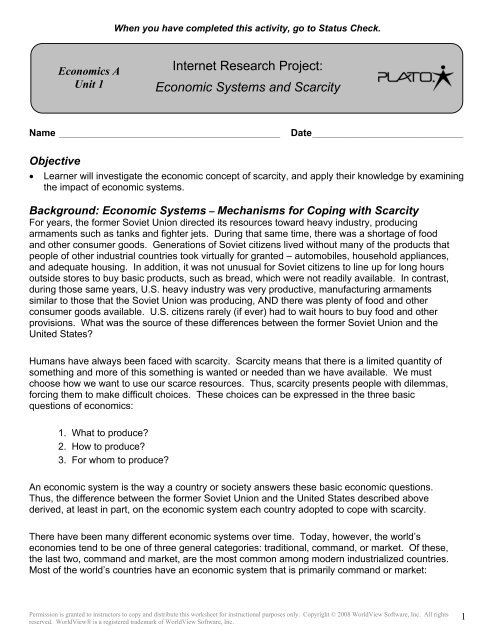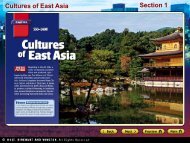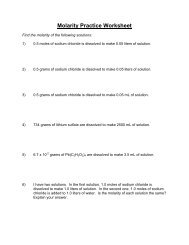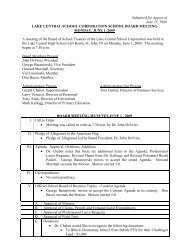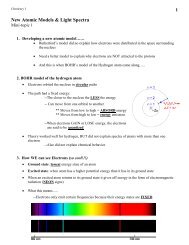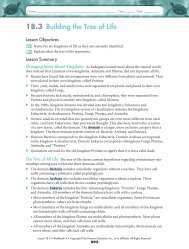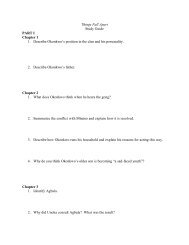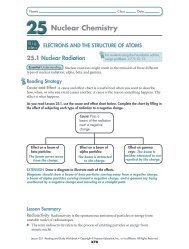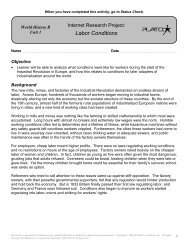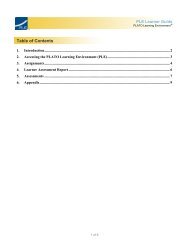Economic Systems and Scarcity - Lake Central High School
Economic Systems and Scarcity - Lake Central High School
Economic Systems and Scarcity - Lake Central High School
You also want an ePaper? Increase the reach of your titles
YUMPU automatically turns print PDFs into web optimized ePapers that Google loves.
When you have completed this activity, go to Status Check.<strong>Economic</strong>s AUnit 1Internet Research Project:<strong>Economic</strong> <strong>Systems</strong> <strong>and</strong> <strong>Scarcity</strong>Name _________________________________________ Date____________________________Objective• Learner will investigate the economic concept of scarcity, <strong>and</strong> apply their knowledge by examiningthe impact of economic systems.Background: <strong>Economic</strong> <strong>Systems</strong> – Mechanisms for Coping with <strong>Scarcity</strong>For years, the former Soviet Union directed its resources toward heavy industry, producingarmaments such as tanks <strong>and</strong> fighter jets. During that same time, there was a shortage of food<strong>and</strong> other consumer goods. Generations of Soviet citizens lived without many of the products thatpeople of other industrial countries took virtually for granted – automobiles, household appliances,<strong>and</strong> adequate housing. In addition, it was not unusual for Soviet citizens to line up for long hoursoutside stores to buy basic products, such as bread, which were not readily available. In contrast,during those same years, U.S. heavy industry was very productive, manufacturing armamentssimilar to those that the Soviet Union was producing, AND there was plenty of food <strong>and</strong> otherconsumer goods available. U.S. citizens rarely (if ever) had to wait hours to buy food <strong>and</strong> otherprovisions. What was the source of these differences between the former Soviet Union <strong>and</strong> theUnited States?Humans have always been faced with scarcity. <strong>Scarcity</strong> means that there is a limited quantity ofsomething <strong>and</strong> more of this something is wanted or needed than we have available. We mustchoose how we want to use our scarce resources. Thus, scarcity presents people with dilemmas,forcing them to make difficult choices. These choices can be expressed in the three basicquestions of economics:1. What to produce?2. How to produce?3. For whom to produce?An economic system is the way a country or society answers these basic economic questions.Thus, the difference between the former Soviet Union <strong>and</strong> the United States described abovederived, at least in part, on the economic system each country adopted to cope with scarcity.There have been many different economic systems over time. Today, however, the world’seconomies tend to be one of three general categories: traditional, comm<strong>and</strong>, or market. Of these,the last two, comm<strong>and</strong> <strong>and</strong> market, are the most common among modern industrialized countries.Most of the world’s countries have an economic system that is primarily comm<strong>and</strong> or market:Permission is granted to instructors to copy <strong>and</strong> distribute this worksheet for instructional purposes only. Copyright © 2008 WorldView Software, Inc. All rights1reserved. WorldView® is a registered trademark of WorldView Software, Inc.
mostly answered in the markets, we call "market." However, all of these are really mixedeconomies.To underst<strong>and</strong> why this blend evolved, consider the task of taking care of the poor. A purelycomm<strong>and</strong> economic system would, first, tell farmers which crops to grow <strong>and</strong> how much of each.Second, they would set up a distribution system that allots each person a set amount of theproduction. A purely market system would rely on private charities to provide for the poor.However, neither of the two systems’ methods for taking care of the poor works over the longterm. Countries that tried a comm<strong>and</strong> approach had problems in getting farmers to cooperate intheir production of food crops because the farmers had no incentive to produce what they wereasked to produce. Also, the distribution systems set up were flawed <strong>and</strong> subject to problems.Countries with market systems have not found that private charities are a very reliable way ofhelping the poor – they seldom have enough resources to provide for everyone in need. So,countries with comm<strong>and</strong> systems (such as the former Soviet Union) moved away from them, whilemany countries with market systems have decided to have more government involvement thanwhat a purely market economy should have. Thus, some (including the United States) haveincentives to increase the production of food (such as subsidies to farmers), as well as programsto help the poor buy food. The subsidies to farmers increase the supply of agricultural products<strong>and</strong> keep their prices low, while programs such as food stamps help people buy food.Permission is granted to instructors to copy <strong>and</strong> distribute this worksheet for instructional purposes only. Copyright © 2008 WorldView Software, Inc. All rights3reserved. WorldView® is a registered trademark of WorldView Software, Inc.
Internet Research PrimerHow to Determine If an Internet Source Is AuthoritativeA lot of information is available on the Internet, but not all of it is reliable. One of the most importantparts of Internet research is determining whether or not the information published on a Web site canbe relied upon to be correct. The first step is to learn who publishes the Web site.Sometimes, the Web address of the site can give useful information: .gov indicates a site publishedby the U.S. government; .mil, the U.S. military; .edu or .ac (sometimes with a country codeafterwards, for example, .ac.uk), an educational institution such as a college; <strong>and</strong> .int, an internationalorganization. A Web address ending in a two-letter code such as .uk or .ca indicates that the Website is based in a foreign country. Finally, .com, .net, .org, <strong>and</strong> .biz can be registered by anyindividual or type of organization. (Although .org is primarily used by nonprofit organizations, this isnot strictly enforced.)In general, governments <strong>and</strong> international organizations are the most trustworthy, followed byeducational institutions (particularly colleges <strong>and</strong> universities). Next in reliability are large nonprofitorganizations <strong>and</strong> corporations. Least authoritative are Web sites maintained by small organizationsor individuals. This is just a general rule. It is important that you determine the source of any Website you want to use <strong>and</strong> decide for yourself how reliable it is. Almost any organization may be biasedin terms of what information it decides to place on the Web site <strong>and</strong> how it presents that information –particularly if it wants to sell you a product or service or has a particular cause or issue to promote.For example, the National Rifle Association (NRA) is a very large legitimate organization – but alsoone with a specific issue to promote <strong>and</strong> publicize.Activities1. The following questions are based on the CIA’s World Factbook available online athttps://www.cia.gov/library/publications/the-world-factbook/index.html.a. Select Mexico from the “Select a Country or Location” dropdown list, then choose“Economy” from the list of Categories. Read the “Economy - overview” section. What kindof an economy does Mexico have? What percentage of the population lives below theasset-based poverty line? (You will need to scroll down the page.)____________________________________________________________________________________________________________________________________________________________________________________________________________________________________________________________________________________________________________________Permission is granted to instructors to copy <strong>and</strong> distribute this worksheet for instructional purposes only. Copyright © 2008 WorldView Software, Inc. All rights4reserved. WorldView® is a registered trademark of WorldView Software, Inc.
. Select North Korea (Korea, North) from the “Select a Country or Location” dropdown list,then choose “Economy” from the list of Categories. Read the “Economy - overview”section. What kind of an economy does North Korea have?________________________________________________________________________________________________________________________________________________________________________________________________________________________________________________________________________________________________________________________2. Go to the U.S. Department of Commerce Bureau of <strong>Economic</strong> Affairs, located athttp://www.bea.gov/. Select the tab marked “glossary,” then click on the letter “G.” What is thedefinition of “gross domestic product (GDP)”? How is that different from “gross nationalproduct (GNP)”?_________________________________________________________________________________________________________________________________________________________________________________________________________________________________________________________________________________________________________________________________________________________________________________________________3. Go to the United Nations Statistics Division’s glossary, located athttp://unstats.un.org/unsd/snaama/glossary.asp. Click on “GDP per capita.” What is thedefinition? What does it indicate about a country?____________________________________________________________________________________________________________________________________________________________________________________________________________________________________________________________________________________________________________________Permission is granted to instructors to copy <strong>and</strong> distribute this worksheet for instructional purposes only. Copyright © 2008 WorldView Software, Inc. All rights5reserved. WorldView® is a registered trademark of WorldView Software, Inc.
ProjectEvery year, the International Monetary Fund (IMF), the World Bank, <strong>and</strong> the United Nationspublish lists that rank countries according to their per capita Gross Domestic Product (GDP).They also publish lists that rank countries according to the proportion of the population thatlives below the poverty line. Go to the United Nations Cyberschoolbus Web site,http://www.un.org/cyberschoolbus. Select “World Hunger” from the Curriculum list; then clickon the “Hunger in the World” link. Read the “Hunger <strong>and</strong> Malnutrition” section, then click onthe “World Hunger Map” link.Choose a country where a high proportion of people are undernourished, then a country wherea low proportion of people are undernourished. Write a report that compares their economies.Why do you think that there is a difference in the proportion of undernourished individuals?Does the nature of the country’s economy have an effect? Why or why not? (Hint: You canuse the United Nations <strong>School</strong>bus Web site (http://www.un.org/cyberschoolbus) to identify thecountries to study. You can also use this Web site to get information about the economies ofthe countries you select. You can also obtain country economic information by using the CIAWorld Factbook at https://www.cia.gov/library/publications/the-world-factbook/index.html, theInternational Monetary Fund’s Web site (http://www.imf.org/external/index.htm), the WorldBank’s Web site (http://www.worldbank.org/), the Human Development Report of the UnitedNations Development Programme (http://hdr.undp.org/en/ ), in addition to other Web sites.)Permission is granted to instructors to copy <strong>and</strong> distribute this worksheet for instructional purposes only. Copyright © 2008 WorldView Software, Inc. All rights6reserved. WorldView® is a registered trademark of WorldView Software, Inc.
When you have completed this activity, go to Status Check.<strong>Economic</strong>s AUnit 2Internet Research Project:Supply, Dem<strong>and</strong>, <strong>and</strong> PriceName _________________________________________ Date____________________________Objective• Learner will study the relationship between market price, <strong>and</strong> dem<strong>and</strong> <strong>and</strong> supply by looking at a“real-life” example.Background: It Is All about Dem<strong>and</strong> <strong>and</strong> SupplyThe winter of 2006-2007 was mild by historical st<strong>and</strong>ards. In the northern United States,temperatures stayed above normal, while snowfall was below normal. Yet Americans paid muchmore to heat their homes than the previous winter, <strong>and</strong> they paid more for gasoline for their cars. Thereason? Skyrocketing heating oil <strong>and</strong> gasoline prices. Heating oil <strong>and</strong> gasoline are both producedfrom crude oil; <strong>and</strong> crude oil prices almost doubled in a year – from $38 a barrel in December 2005 to$75 a barrel in December 2006.Crude oil has long been considered a valuable resource – inspiring its nickname, “black gold.”Sudden <strong>and</strong> steep crude oil price increases are not a new phenomenon. In 1973, the Organization ofPetroleum Exporting Countries (OPEC) arbitrarily raised their prices first 70%, then later 130%, inretaliation for support given to Israel in the Yom Kippur War that year. From the fall of 1973 to thespring of 1974, the price of crude oil went from $3.50 a barrel to more than $10. Since the UnitedStates at that time relied on OPEC members for a substantial portion of its oil, prices of gasoline <strong>and</strong>other oil-based products jumped substantially in the United States. A new energy crisis began in1979, in the wake of the political instability caused by the overthrow of the shah of Iran. Americanswere forced to wait on long lines to obtain gas for their automobiles. For the period from 1979 to1981, crude oil prices rose from $10 to $36, before coming back to $10 in 1986.Crude oil is not the only product that has wide price swings. The prices of fresh fruits <strong>and</strong> vegetables<strong>and</strong> other agricultural products that people buy every day constantly fluctuates. In fact, the price ofevery commodity rises <strong>and</strong> falls over time. A commodity is anything of value to people that can betransported (moved) <strong>and</strong> traded, although the term is most commonly used with unspecialized bulkproducts such as corn, wheat, petroleum, <strong>and</strong> coal. Commodity price changes affect everyone whotrades in them – those who buy the product <strong>and</strong> those who sell it. What determines the price of acommodity? Why do some commodities have higher prices than others? What causes their price tochange over time?These questions are very old. Indeed, Adam Smith, who wrote the first comprehensive bookdescribing economic systems, particularly market ones ("The Wealth of Nations," 1776), examinedthese issues. Smith said that the price of a product is linked to its supply – that is, the price of acommodity is determined by the cost to produce <strong>and</strong> supply it. Other economists disagreed withSmith <strong>and</strong> asserted that price is linked to dem<strong>and</strong> – that is, the price of a commodity is determined byits perceived value to consumers. Today, economists agree that price is determined by both themarket dem<strong>and</strong> <strong>and</strong> supply for that commodity.Permission is granted to instructors to copy <strong>and</strong> distribute this worksheet for instructional purposes only. Copyright © 2008 WorldView Software, Inc. All rights1reserved. WorldView® is a registered trademark of WorldView Software, Inc.
In a market economy, commodities are bought <strong>and</strong> sold through markets. A market is defined as themechanism, process, or means by which buyers <strong>and</strong> sellers are brought together – that is, thebargaining between those who are producing the product <strong>and</strong> those who want to consume it. Twothings are determined by this bargaining: how much will be bought <strong>and</strong> sold (the quantity) <strong>and</strong> atwhat price. The price is the point at which the quantity dem<strong>and</strong>ed equals the quantity supplied. Thisprice is called the “market price” or "equilibrium price." ("Equilibrium" means that a state of balanceexists between two things.)However, the supply <strong>and</strong> dem<strong>and</strong> of commodities can change over time, <strong>and</strong> therefore the prices ofcommodities change over time, reflecting changes in the dem<strong>and</strong> <strong>and</strong>/or supply of thesecommodities. The changes in dem<strong>and</strong> <strong>and</strong> supply may be caused by changes in consumerpreferences, production costs, weather conditions, among other factors. For example, the prices offresh fruits <strong>and</strong> vegetables go up or down depending on their availability. Their availability can beinfluenced both by their seasonal nature <strong>and</strong> factors affecting their production – such as floods,drought, <strong>and</strong> unseasonable freezes. If Florida experiences freezing temperatures, this can directlyaffect the price of oranges in the United States.The crude oil market is an international market because supply <strong>and</strong> dem<strong>and</strong> is affected by producers<strong>and</strong> consumers in many different countries. Oil-producing countries like Canada, Iran, Iraq, Mexico,Nigeria, Norway, Russia, Saudi Arabia, the United States, <strong>and</strong> Venezuela provide the supply of crudeoil. Crude oil is used to produce electricity, fertilizer, gasoline, home heating oil, laundry detergent,plastics, <strong>and</strong> many other products. Thus, consumers throughout the world who use these productsare the ones who ultimately create the dem<strong>and</strong> for crude oil when they purchase the productsproduced from crude oil.The dem<strong>and</strong> for crude oil has been increasing. One major reason is that the economies of some ofthe oil-consuming countries are growing fast. Thus, these countries are increasing their use of crudeoil <strong>and</strong> the products created from it in their industries, infrastructures, <strong>and</strong> lifestyles. China, forexample, has a fast-growing economy. It is increasing its consumption of crude oil because itsindustries are exp<strong>and</strong>ing tremendously in response to a worldwide dem<strong>and</strong> for Chinese-madeproducts, as well as increased consumer dem<strong>and</strong> for automobiles <strong>and</strong> the gasoline to power them asconsumer income increases. What is occurring in China is also occurring in India. The majordem<strong>and</strong> factor behind the increase in oil prices in 2007 was the increase in the quantity dem<strong>and</strong>ed byrapidly developing countries such as China <strong>and</strong> India.The availability of oil (supply) also affects price. If the number of suppliers decreases – or the amounteach supplier provides decreases – prices could increase to reflect this smaller available quantity.The major supply factors behind the increase in oil prices in 2007 included problems in oil-producingcountries: the continued turmoil in Iraq, an Iranian government that is viewed as both unreliable <strong>and</strong>hostile to non-Muslim countries, a Marxist-leaning president in Venezuela, <strong>and</strong> political turmoil inNigeria. Industrial accidents or natural disasters, such as Hurricane Katrina (2005), could also disruptsupplies, <strong>and</strong> result in higher prices.Permission is granted to instructors to copy <strong>and</strong> distribute this worksheet for instructional purposes only. Copyright © 2008 WorldView Software, Inc. All rights2reserved. WorldView® is a registered trademark of WorldView Software, Inc.
Internet Research PrimerBasic Internet SearchingThe Internet contains a vast amount of information, but there is no index or table of contents like abook. In order to find information on your topic, you must use what is called a search engine. Thereare many different search engines available, including AltaVista, Ask.com, Google, Live Search,Yahoo, <strong>and</strong> many others. Google is currently the most popular, but many of the techniques describedhere can be used with most search engines.The first step in using a search engine is to collect a list of terms <strong>and</strong> phrases for your topic that canbe used by the search engine to find Web pages in which you are interested. One technique thathelps is to use words or phrases that are unique to the topic. When entering multiple words orphrases in a search engine’s search box, it is helpful if you connect them with what are called“Boolean operators.” Boolean operators are named after the English mathematician, George Boole(1815-1864). They are words that help the search engine determine if a Web page is likely to havewhat you are interested in. The most commonly used Boolean operators are AND <strong>and</strong> OR.With Google, the Boolean operator AND is the default – if you enter multiple words with nothing but aspace between them, it is assumed that the word AND is between them. So, for example, if youentered oil price in the search box, Google would search for both “oil” <strong>and</strong> “price” <strong>and</strong> would list Webpages in its search results that contain both the word “oil” <strong>and</strong> also the word “price.” If you entered oilOR price, Google would list Web pages in the search results that contain either the word “oil” or theword “price” – <strong>and</strong> some Web pages would have one word but not the other.Note that if you entered either oil price or oil AND price, the Web pages in the search results wouldcontain both the word “oil” <strong>and</strong> also the word “price.” However, these Web pages would notnecessarily include the specific phrase “oil price” with the words next to each other <strong>and</strong> in that order.In order to search for the phrase “oil price” you should enter "oil price" with the quotation marksaround the phrase. This would cause the search engine to return only pages that contain the phrase“oil price.”You can include Boolean operators <strong>and</strong> phrases together in one search. For example, if you entered"oil price" 2008 in the search box, Google would return pages with the phrase “oil price” <strong>and</strong> thedate “2008.” You can also use more than one Boolean operator in a search, but you should includeparentheses when you do this, so that the search engine knows exactly what you want to search for.The search (2008 OR modern) "oil price" will return a list of Web pages that includes the phrase “oilprice” <strong>and</strong> also includes either the date “2008” or the word “modern.”While AND <strong>and</strong> OR are the two most commonly used Boolean operators, there is another Booleanoperator that can also be used – NOT. The NOT Boolean operator limits the search results to thoseWeb pages without the word or phrase that follows the NOT. With Google searches, the BooleanNOT operator is represented by the - (minus) symbol <strong>and</strong> must come right before the word or phraseto be excluded (no space allowed). For example, if you keyed "petroleum production" -Texas inGoogle’s search box, Google would return all Web pages that included the phrase “petroleumproduction” except those which also had the word “Texas.” The NOT operator can also be applied toa phrase to exclude Web pages that have that phrase from the search results. If you want to excludePermission is granted to instructors to copy <strong>and</strong> distribute this worksheet for instructional purposes only. Copyright © 2008 WorldView Software, Inc. All rights3reserved. WorldView® is a registered trademark of WorldView Software, Inc.
a phrase, the NOT operator should be placed in front of the quotation marks that surround the phrase– for example, -"petroleum production".There are other search techniques that do not involve Boolean operators. One of the most commonis to use a symbol called a “tilde” (~). A tilde is used in a search box to search for a word or any of itscommon synonyms. Like the minus symbol used for the NOT, the tilde must appear right before theword you want it to work with (no space allowed). For example, if you key ~help, the search enginewill not only search for the word “help,” but will also search for the words “guide,” “manual,” “faq,”“support,” “tutorial,” “helping,” “tips,” <strong>and</strong> “problems.”Another technique that does not involve Boolean operators is to use what are called “proximity”operators, such as “adjacent,” “near,” <strong>and</strong> “with.” In general, proximity operators are similar in use tothe AND Boolean operator. They ensure that two terms or phrases will be on the Web pagesreturned in the search results. If you use the AND Boolean operator to link these terms or phrases,the two could be in two completely different places on a Web page – not near each other. Thedifference with proximity operators is that the two terms or phrases must be somewhat close togetheror the Web page will not be included in the search results. Many search engines allow the proximityoperator to be followed by a number (with no space) to specify the maximum separation. Forexample, if you keyed Franklin with2 Roosevelt, the search results would include only those Webpages that contained BOTH “Franklin” <strong>and</strong> “Roosevelt” with only two words (or less) between them.Thus, Web pages with “Franklin Roosevelt,” “Franklin-Jacques Roosevelt,” <strong>and</strong> “Franklin JacquesRoosevelt” would all be included in the search results. However, Web pages with “Roosevelt,Franklin” would not.Activities1. The following questions are based on the Department of Energy Web site available athttp://www.energy.gov.a. Place your mouse pointer over the “Energy Sources” link for a list of further choices. Clickon the “Fossil Fuels” link. What fuels are identified as fossil fuels? What percentage doesthe Department of Energy say fossil fuels provide of the energy consumed in the UnitedStates?_________________________________________________________________________________________________________________________________________________________________________________________________________________________________________________________________________________________________________________________________________________________________________________________________Permission is granted to instructors to copy <strong>and</strong> distribute this worksheet for instructional purposes only. Copyright © 2008 WorldView Software, Inc. All rights4reserved. WorldView® is a registered trademark of WorldView Software, Inc.
. Place your mouse pointer over the “Science <strong>and</strong> Technology” link for a list of furtherchoices. Click on the “Climate Change” link. What strategies does the Department ofEnergy say its Office of Fuel Energy is pursuing to reduce carbon emissions that contributeto global climate change?______________________________________________________________________________________________________________________________________________________________________________________________________________________________________________________________________________________________________________________________________________________________________________________________________c. Place your mouse pointer over the “Prices <strong>and</strong> Trends” link for a list of further choices.Click on the “Energy Statistics” link, which will take you to the Web site for the EnergyInformation Administration, a statistical agency of the Department of Energy. Under“Energy Sources,” click on the “Petroleum” link. Under the “Imports/Exports & Pipelines”section of the “U.S. Data” column, click on the “U.S. Imports by Country of Origin” link.Select “Annual-thous<strong>and</strong> Barrels” from the “Period-Unit” dropdown list. Scroll down the listof countries. From which country did the United States import most of its oil in the mostcurrent year listed?________________________________________________________________________________________________________________________________________________________________________________________________________________________________________________________________________________________________________________________________________________________________________________________________________________2. Go to the Fuel Facts Web site of the American Petroleum Institute (an organization supportedby the oil industry), at http://www.factsonfuel.org. In the “Home Fuels” section in the leftcolumn, click on the “Natural Gas” link. Read the section on “Natural Gas Supply <strong>and</strong>Dem<strong>and</strong>.” According to the Web site, what is currently affecting the price of natural gas?___________________________________________________________________________________________________________________________________________________________________________________________________________________________________________________________________________________________________________________________________________________________________________________________________________Permission is granted to instructors to copy <strong>and</strong> distribute this worksheet for instructional purposes only. Copyright © 2008 WorldView Software, Inc. All rights5reserved. WorldView® is a registered trademark of WorldView Software, Inc.
ProjectThe United States imports a great deal of crude oil that is used to make gasoline. Make aposter that answers the following questions: From where does the crude oil come? How muchdoes the United States import? How much crude oil does the United States produce itself?What factors, in addition to the price of crude oil, affect the price of gasoline? (Hint: Amongother sources, use the following Web sites: http://www.factsonfuel.org, maintained by theAmerican Petroleum Institute; http://www.energy.gov, maintained by the Department ofEnergy; <strong>and</strong> http://www.fpa.org, maintained by the Foreign Policy Association [for this one, keyin “Analysis: The Price of Oil” in the search text box]).Permission is granted to instructors to copy <strong>and</strong> distribute this worksheet for instructional purposes only. Copyright © 2008 WorldView Software, Inc. All rights6reserved. WorldView® is a registered trademark of WorldView Software, Inc.


